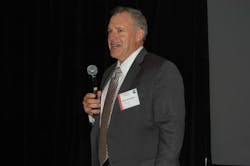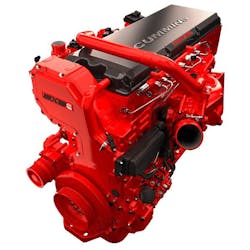“The trucking industry is going through a transition where the road that led to 2010 will be very different from the road to 2020,” Crompton (at right) explained. “It’s what many believe is a subtle shift but one that we feel will be significant, which is why we are focusing on ‘redefining efficiency’ in that new context.”
Srikanth Padmanabhan, VP of the heavy-duty, mid-range and light-duty (HMLD) engine business at Cummins, added that means taking a more “holistic” view of truck engine operation; delivering products that provide better fuel economy, environmental sustainability, reliability, durability and performance.
To that end, Cummins showed off several enhancements to its engines and related systems that are designed to “redefine efficiency” from this perspective.
The first is a new electronic control system called “ADEPT,” which is short for Advanced Diesel Electric Powertrain Technology.
Jim Fier – recently promoted to VP of HLMD engineering for Cummins’ engine business effective April 1 – explained that ADEPT is a new suite of electronic features that aims to deliver fuel-economy gains of up to 3% initially for ISX15 customers operating with automated manual transmissions (AMTs).
Available starting this summer, ADEPT packages together to two established features to boost fuel savings:
- SmartCoast: This disengages a truck’s engine automatically from the driveline when going downhill, returning it to idle to reduce drag, conserve vehicle momentum and, ultimately, improve fuel economy.
- SmartTorque2 (ST2): This taps into the same torque management intelligence first introduced on the SmartAdvantage Powertrain to help eliminate unnecessary downshifts and keep the engine operating in the most fuel-efficient “sweet spot.”
Next is the new 2017 model upgrade to the ISX15 heavy-duty engine. Generating 400 hp to 605 hp, the 2017 ISX15 will be offered in two distinct packages: one optimized for customers seeking maximum fuel economy, with the other aimed at operators seeking high performance.
Fier noted that design updates to the 2017 model ISX15 (seen at right) include a more responsive and efficient turbocharger, further optimization for downspeeding, integrated ADEPT technology, a reformulation of the engine’s combustion “recipe,” and continued reductions in parasitic energy losses.
Another key piece of the 2017 model ISX15 engine is the development of the new EcoFit single module aftertreatment system from the company’s Cummins Emission Solutions division. Fier said the “single-piece” design reduces the device’s size by 60% and weight by 40% compared to the prior version.
“We did all of that and yet still improved its efficiency,” he added.
Yet Amy Boerger – newly appointed VP-North American engine business for Cummins effective April 1 – pointed out that new telematics packages are being deployed alongside those new products to help improve the “efficiency” of customer care.
“By using telematics, we can transmit data instantly to Cummins dealers and distributors to help rBoerger (at right) also added that the company’s Connected Diagnostics suite – introduced back in February at the Technology & Maintenance Council annual meeting – is the key piece of technology that will make remote service work; technology that will be officially offered starting in April.
“We already have 10,000 trucks and buses using our Connected Diagnostics package today,” she added.
Omnitracs LLC is one telematics provider that’s already signed up to provide the Cummins Connected Diagnostics application via its mobile computing platforms (MCPs), enabling customers to access near-real-time engine diagnostic information.
“Today, fleets are easily inundated with an immense amount of truck information that they don’t always have the resources to interpret, which limits its usefulness,” noted Richard Glasmann, VP-OEM strategy, sales and marketing for Omnitracs in a separate statement.
“Connected Diagnostics enabled by our ‘Fault Monitoring’ application will support a proactive approach to engine maintenance and repair while enhancing the value that we deliver to our mutual customers,” he added.
Cummins’ Boerger added that the company plans to show off those and other new offerings via its “Cummins Redefining Tour” featuring a fleet of Cummins ISX15-powered heavy-duty trucks that will crisscross the U.S. and Canada from June through October this year.
During the tour, she said customers will have an opportunity to learn about ADEPT and Connected Diagnostics while viewing some of its 2017 prototype engines.
The 2015 Redefining Tour “not only demonstrates our products in a real-world application, it also allows us to bring the product demonstrations and displays directly to our customers – some of whom we don’t have the opportunity to engage with on a regular basis,” Boerger noted.
About the Author
Sean Kilcarr
Editor in Chief
Sean Kilcarr is a former longtime FleetOwner senior editor who wrote for the publication from 2000 to 2018. He served as editor-in-chief from 2017 to 2018.



